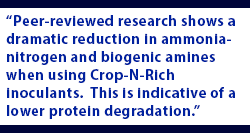
8 ways to control alfalfa quality
 By Nathan Hrnicek
By Nathan HrnicekVita Plus forage team members will soon field questions from dairy producers asking when they should cut alfalfa to gain the highest yield while maintaining a certain level of quality. Alfalfa quality can be measured by different metrics, with the most common being relative feed quality (RFQ), crude protein (CP) content, and a newer metric called undigestible neutral detergent fiber (uNDF240).
For this article, we want to discuss how you can achieve optimal levels of forage quality by fine-tuning common harvest processes.
Typically, to achieve higher-quality alfalfa, the crop is harvested earlier (between 23 and 28 days). Harvesting in the early- to mid-bud stage is still the best and most practical way to maximize quality.
Another way to maximize quality is to maximize leaf retention. The leaves are where you get an increase in quality because they are more digestible compared to the stems. More overall leaves means lower undigestible material, which means higher-quality alfalfa.
 To help maintain or increase leaf retention and improve quality, here are some other practices you can enact during the harvest process:
To help maintain or increase leaf retention and improve quality, here are some other practices you can enact during the harvest process:
- Target a cutting height on pure alfalfa stands of at least 2.5 inches. This height allows the alfalfa to dry more evenly.
- Consider your discbine settings. Aggressively setting the discbine will help pick up lodged alfalfa, but it will also increase the ash content in the alfalfa, thus reducing the overall quality.
- Utilize wide-swathing to help evenly dry the alfalfa. This helps avoid having dry patches within a windrow that are more prone to increased leaf loss during chopping.
- Use a merger instead of a rake to increase leaf retention and reduce ash content.
- Target a dry matter (DM) range of 40 to 45 percent. Achieving an ideal DM will increase leaf retention and aid in achieving the proper packing density and a robust fermentation.
- Use the appropriate Vita Plus Crop-N-Rich® forage inoculant. Peer-reviewed research shows a dramatic reduction in ammonia-nitrogen (percent of total nitrogen) and biogenic amines when using Crop-N-Rich inoculants. This is indicative of a lower protein degradation.
- Cover the alfalfa quickly with an oxygen-barrier plastic, such as Silostop®, to help protect all the work you put in to produce the best crop possible.
- Minimize wheel traffic on the field to avoid damaging alfalfa crowns. This will allow for more stems per crown, leading to finer stem regrowth.
Contact your Vita Plus consultant to learn more about on any of the information above, as well as the tools and resources available to help you reach your unique forage goals.
This article was originally written for the April edition of Vita Plus Forage Foundations. Click here for more forage expertise.
About the author: Nathan Hrnicek is a Vita Plus forage products specialist, working closely with producers and Vita Plus and dealer staff in Michigan, Indiana, Illinois, and Ohio. He grew up on his family’s 1,200-acre diversified crop and livestock farm. He earned his associate’s degree in general agriculture from the Ivy Tech Community College in Lafayette, Indiana. He built his agronomy and forage expertise through several career experiences in seed sales as well as a sampling laboratory.
| Category: |
Crop varieties Dairy Performance Equipment Forage harvesting Forage inoculants Silages |

